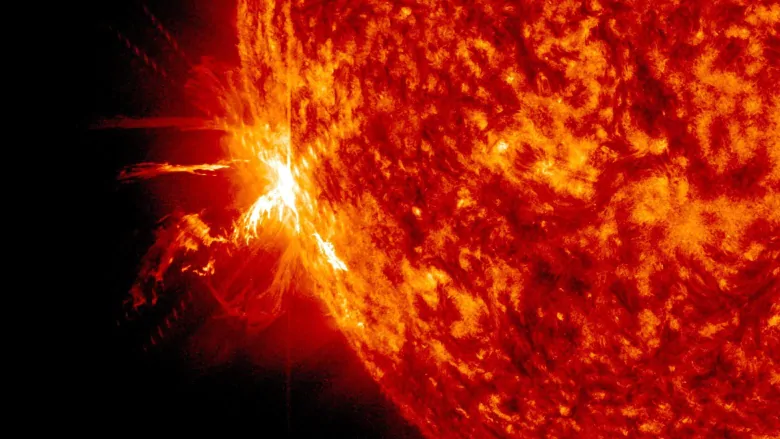Solar storms may be linked to mass grey whale strandings

Each year, grey whales travel more than 16,000 kilometres along the Pacific Coast, from Mexico to Alaska and back. But every so often, many of them — sometimes hundreds — become stranded.
It’s not completely clear how grey whales navigate the depths of the ocean during this long journey, but one hypothesis is they use Earth’s magnetic field as a sort of road map.
Now a new study, published in the journal Current Biology, further supports that hypothesis, going so far as to suggest the reason for the mass strandings could be linked to solar storms and how that activity affects Earth’s magnetic field.
The sun and Earth
The sun’s activity doesn’t take place in isolation; Earth — in fact, every planet in the solar system — is affected by it.
One form of solar activity comes in the form of sunspots, the darker, cooler regions that form on the sun’s surface.
Sunspots have magnetic field lines that can become entangled, like an elastic band, and can snap, releasing a solar flare. These flares produce large eruptions of electromagnetic radiation that can last from minutes to hours.
Travelling at the speed of light, if one of these eruptions reach Earth, it can cause radio blackouts. They also affect animals.
Many species, such as lobsters, frogs and snails, use magnetoreception — or a sense that allows them to use the Earth’s magnetic field — for navigation.
There could be two ways in which animals can sense a magnetic field.
One is they have magnetite particles somewhere in their bodies, or even throughout it — something the study’s lead author Jesse Granger refers to as “little iron compass needles.”
Another explanation could be a method known as “radical pair mechanism,” where a magnetically sensitive chemical reaction is triggered depending on which way an animal is facing.
While lots of research supports both hypotheses, there has been no direct evidence recorded.
Whale GPS
Granger — a PhD biology student at Duke University who specializes in sensory migration — wanted to specifically explore how animals used magnetoreception to navigate. She was also intrigued by the idea that grey whales can navigate such vast distances with such precision.
“Meanwhile, I can’t find my way to the grocery store without my GPS,” she joked. “How are they doing this? This is crazy.”
Granger and her co-authors examined 186 live strandings — whales that had “no signs of injury, illness, emaciation, or human interaction” — dating from 1985 to 2018, and found they occurred “significantly” more often on days where the sun had several sunspots, compared to days it didn’t.
On those days, the chances of a stranding more than doubled.
Granger’s first hypothesis was that the sun pushes out high-particle storms, which, in turn, push around Earth’s magnetic field, disorienting the whales.
“The whale thinks it’s on Third Street when it’s actually on Eighth Street,” said Granger. “And it ends up, perhaps, in a pinch point — somewhere it can’t get out of. Or it ends up in a very high riptide, and then gets sucked on the land.
“Perhaps if it had a better idea of where it was located, it wouldn’t have ended up in a bad place.”

But the findings didn’t support that. So they turned to a variable known as radio frequency noise as something that could potentially affect the whales’ navigation.
“We know that radio frequency noise will prevent an animal from sensing magnetic fields,” said Granger. “It was like a light bulb went off.”
The researchers had a new hypothesis.
“Do we think that perhaps solar storms are turning off [the whales’ ability] to see its magnetic field altogether?” said Granger. “Like they had a GPS and it just turns it off mid-trip?”
Coupled with the sunspot data, they saw a stronger relationship between solar storms and the strandings.
But Granger warns that correlation doesn’t necessarily lead to causation.
“We were really excited,” she said. “But a lot of caution is still needed when you’re talking about these sorts of statistical correlation studies.… This is what we found — and that’s one explanation for why we would see that relationship.”
Klaus Heinrich Vanselow is a marine biology expert at the University of Kiel in Germany who researches sperm whale strandings in the North Sea and has written several papers on with similar findings.
He echoes the idea that the paper is a good start at identifying the potential interactions between radio frequencies and whale strandings, but that more research needs to be done.
“Because they say it’s only a property of the phenomenon — it’s not the real interaction,” he said. “I think in the future, there must be much more research.”





